47 Seconds From Hell: A Challenge To Navy Doctrine
Posted on

WASHINGTON: Someone shoots a cruise missile at you. How far away would you like to stop it: over 200 miles out or less than 35?
If you answered “over 200,” congratulations, you’re thinking like the US Navy, which has spent billions of dollars over decades to develop ever more sophisticated anti-missile defenses. According to Bryan Clark, until 12 months ago a top advisor to the nation’s top admiral, you and the Navy are wrong.
Buying small numbers of relatively large, long-ranged, expensive interceptors like the SM-6 gives us “false confidence,” Clark writes in a new report, because a well-equipped enemy like China or even Iran could just keep lobbing cheap missiles at us until we run out of silver bullets to shoot them down. Instead, we need to invest in long-range offensive missiles to kill the other guy, ideally before he even fires. Leave defense to relatively small, short-ranged, and affordable interceptors, such as the Sea Sparrow, that ships can carry in bulk, supported by electronic jamming and — in the near future — lasers, neither of which ever runs out of ammunition.
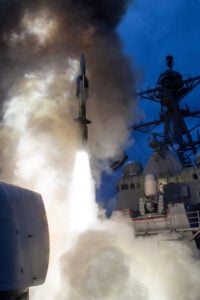
The USS John Paul Jones test-fires an SM-6 in June
The profoundly counter-cultural catch for Navy commanders, Clark admits, is that they’d have to let enemy missiles get within 35 miles (30 nautical miles) of their ship before shooting them down. I did some quick calculations based on this distance and the reported top speeds of modern anti-ship weapons like China’s 1.5-ton YJ-12. Then I did a double-take and asked Clark to check my math. He confirmed the figures: At Mach 3.5, a cruise missile can cover 30 nautical miles in approximately forty-seven seconds.
“The pucker factor’s going to be higher,” Clark acknowledged to reporters when he briefed them on his recommendations this week. “But our current air defense scheme gives us a false sense of confidence.”
Yes, we can start engaging incoming missiles hundreds of miles out, with plenty of time to fire again and again at anything that gets through, using successively shorter-range interceptors, from the various variants of the Standard Missile to the Sea Sparrow to the Rolling Airframe Missile, until at the last second the automated Gatling gun called the Phalanx Close-In Weapons System (CIWS) sprays bullets at any “leakers.” But even if you give up on carrying offensive weapons, an Aegis destroyer‘s Vertical Launch System (VLS) can carry at most about 100 of the longest-range interceptors. Even in the best possible case, the 101st missile will get through.
100 modern cruise missiles cost at most $300 million. An Aegis destroyer costs over $1.5 billion. The aircraft carrier it protects? Easily $6 billion, not counting planes. A relatively impoverished adversary like North Korea or Hezbollah might not be able to scrape together 100 missiles. A richer country like Iran, let alone China, can trade cheap missiles for expensive ships all day.
A good offense isn’t just the best defense in this scenario: It’s the only defense. Relying on small, cheap, short-range interceptors lets you carry more defensive weapons and shoot down more incoming missiles, which is important, but it only delays the inevitable unless you stop the other guy from shooting. That means shooting him — which is a real problem for the US Navy right now, because its anti-ship missiles are badly outranged by what Russia, China, and even India are selling worldwide.
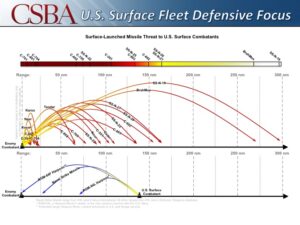
US Navy anti-ship missiles are badly outranged by Russian, Chinese, and Indian counterparts.
Turning The Navy Inside Out
Clark’s strategy would turn the surface fleet inside out, replacing its current defensive focus with what he calls “offensive sea control.” It’s about much more than the mix of missiles.
Today, for example, the Navy devotes about 18 of its most advanced Aegis ships to ballistic missile defense, rotating them through continual patrols off the coasts of allies in Europe, the Persian Gulf, and Asia. Politically, it’s a high priority. In Clark’s offensive mindset, it’s a waste of warships’ time. He wants those 18 cruisers and destroyers armed for bear and ranging freely through the seas. He’s even willing to give up part of the shipbuilding budget to pay for land-based missile defenses to replace them. If you’re defending a fixed territory, he argues, why commit several $1.5-plus billion Aegis ships when a $570 million Aegis Ashore system would do as well?
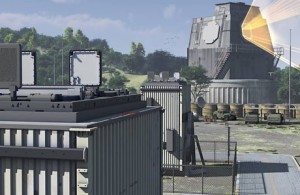
Aegis Ashore missile defense system concept
In Clark’s offense-oriented fleet, every class of ship essentially moves up a rung on the ladder of combat power. Aegis destroyers and cruisers swap out defensive missiles for offensive ones in their Vertical Launch Systems. The Littoral Combat Ship gets upgunned with a small VLS of its own so it can take over some air-defense and escort missions from the Aegis ships, as well as play a supporting role in offensive strikes. Currently unarmed auxiliaries like the Joint High Speed Vessel (JHSV) and Afloat Forward Staging Base (AFSB) move up to take on defensive missions currently reserved for LCS, getting outfitted with the LCS’s mine-clearing kit, its maritime security module, or even rail guns for fleet defense.
Many of these ideas are logical extensions of things the Navy’s already doing. Adm. Jonathan Greenert, the Chief of Naval Operations and Clark’s old boss, has sought to free up Aegis cruisers and destroyers for high-threat environments like the Western Pacific by using auxiliary ships for less dangerous missions. The Navy’s even testing a prototype rail gun on a JHSV and a low-power laser on a AFSB — although I’ve heard no one but Clark suggest using those ships as operational platforms for these weapons. As for the Littoral Combat Ship, Defense Secretary Chuck Hagel has already forced the Navy to relook the LCS and consider a better-armed, more survivable successor — which, for simple reasons of time and cost, will more likely be an upgraded LCS rather than a brand new design. And, after years of reliance on the 65-nautical-mile Harpoon, the Navy has hired Lockheed Martin to build a new Long-Range Anti-Ship Missile (LRASM).
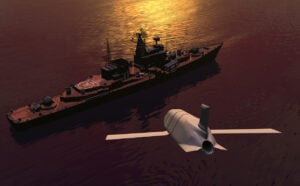
An artist’s depiction of a Lockheed Martin LRASM (Long-Range Anti-Ship Missile) hurtling towards its target.
But Clark recommends some course corrections. For example, the LRASM is derived from an air-launched missile with a large warhead — 1,000 pounds — and relatively modest range — 300 miles. Lighten the warhead so you can add more fuel, Clark argues, and you can get a 1,000-mile missile that still does adequate damage to disable high-tech warships, whose dependence on electronics makes them more fragile than their Cold War predecessors. A 1,000-mile LRASM would also have the reach to hit targets well inland, so with a proper guidance system the same missile could hit surface targets either on land or sea. That would give the Navy much more flexibility and potentially eliminate the need for a specialized Next-Generation Land-Attack Weapon (NGLAW) now being planned.
Then there’s the Raytheon-built Standard Missile. The Navy has invested heavily in upgrading the Standard’s capabilities to intercept incoming enemy missiles. Clark wants to repurpose that same high technology as an offensive weapon capable of killing a range of targets, in the air, at sea, and ashore. He notes that the SM-2 variant already has a oft-forgotten anti-surface-target mode and that the Navy’s adding GPS guidance to the latest model, the SM-6, which would potentially let it hit ground targets. But for Clark, that’s just a beginning. He wants to see the Standard Missiles reserved for killing enemy aircraft, ships, and shore-based missile systems before they launch. The Navy could even make an anti-submarine version of the Standard design, he argues, that would have more than 10 times the range of the current 12-nautical-mile ASROC. As for the ballistic missile defense version of the Standard, the SM-3, Clark would limit it to a small number per ship for emergencies.
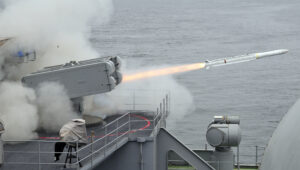
Evolved Sea Sparrow Missile (ESSM) launching
So what would do defense? Primarily, the Evolved Sea Sparrow Missile (ESSM), also a Raytheon product, which the US Navy considers a mere backup to the Standard but which many NATO navies use as their main line of defense. The ESSM also has an anti-surface mode, notes Clark, so it too can be a multi-purpose offensive and defensive weapon. But its main role in his framework is protection: At $1.3 million, it’s a third the SM-6’s cost and one-quarter the size, allowing ships to carry them in the much larger numbers required for defense.
Supplementing the Sea Sparrows would be jammers. Clark particularly prizes the “Block III” upgrade of the Surface Electronic Warfare Improvement Program (SEWIP), scheduled to enter service around 2017. “That’s one of the things that led me to come up with this idea,” Clark said: We’re going to have great jamming, but under current doctrine, “we’re never going to use it,” because its range is limited to at most 30 nautical miles. If you make your stand at 30 nm, however, you can use electronic warfare against some incoming missiles, leading them so far off-target that you don’t have to fire interceptors at them at all.
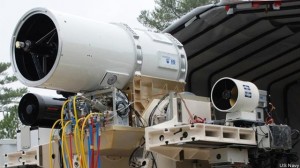
Experimental Navy laser
In the not-too-distant future would come lasers and electromagnetic rail guns. As interceptors, laser beams have the advantage of moving at the speed of light — but with foreseeable 2020s technology, they would only be effective out to 10 nautical miles, Clark told me, making them best as a lightning-fast backstop to the Sparrows and SEWIP. Rail guns, by contrast, can fire over 100 nautical miles, but their projectiles move much slower than lasers and can’t change course like missiles, so they can’t hit fast-moving targets at distances greater than 30 nautical miles. Clark recommends replacing the 5″ cannon on the Aegis destroyers with a 300-plus kilowatt laser once the technology is mature enough; rail guns, which require more power, should go on converted JHSVs.
All these weapons should work together in one computer-controlled defensive network because no human can assign targets fast enough. Clark’s concept allows several very different defenses to take shots at incoming missiles all at once, in parallel, whereas the current method has one interceptor after another take its turn at each incoming missile. The current system tries to shoot down the incoming missiles at long range; the long range component of Clark’s concept is shooting the airplanes, ships, or shore batteries before they launch their missiles.

The Cold War “outer air battle” concept
Shooting The Archer
Despite the futuristic weapons, in many ways Clark’s offensive emphasis is going back to the future. He explicitly endorses the “shoot the archer, not the arrow” doctrine of the 1980s, when the Navy knew it could not possibly intercept swarms of Russian missiles and, instead, focused on killing the bombers that carried them. When the Soviet Union fell, however, the Navy started to take control of the sea for granted.
“The Navy basically admitted in its maritime strategies of the 1990s that sea-control was a thing of the past,” one Hill staffer told me. “So for the next decade they got really good at projecting power ashore with strike fighters and land-attack weapons and let the classic mission of sea control slowly wither on the priority list. Look no further for evidence than the fact PACOM [Pacific Command] put forward an urgent needs request way back in 2008 for a long-range anti-surface weapon to match China’s own anti-surface weapons and we are only now just getting around to providing viable solutions.”
“Bryan’s report provides some excellent ideas,” the staffer said. “Hopefully, the Navy is listening.”
“I’ve had a surprisingly receptive audience with the surface navy,” Clark told reporters. Admirals realize the numbers are not on their side if they play defense against an enemy with lots of missiles, he said. Indeed, many of the recommendations in Clark’s report evolve out of work he did as director of Adm. Greenert’s personal think tank, the Commander’s Action Group (CAG).

Rep. Randy Forbes
Clark’s also had conversations on Capitol Hill, most notably with House seapower chairman Randy Forbes, who praised the report on its release. “Bryan Clark’s new report does an excellent job,” Forbes said in a statement (though the two men disagree on how to modernize Aegis cruisers). “After decades of the Navy operating on the assumption that blue-water sea control is a forgone conclusion, I welcome that this study takes on the conventional wisdom and offers a framework for addressing the very real problem now at hand.”
“I share the desire to explore ways to improve the cost exchange ratio between ship defenses and enemy missiles as well as the need to find innovative ways to bring more offensive, long-range firepower on board our cruisers, destroyers, and small surface combatants,” Forbes said. “The issues this report raises deserve consideration by both the Navy and Congress.”
Coming from the chairman of the House subcommittee on seapower, that’s not idle wishing: That’s a plan of action.

Subscribe to our newsletter
Promotions, new products and sales. Directly to your inbox.
